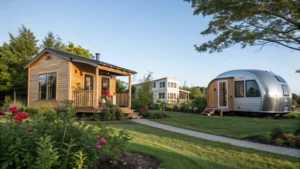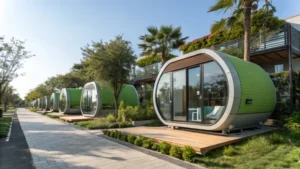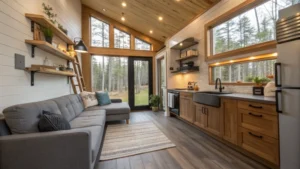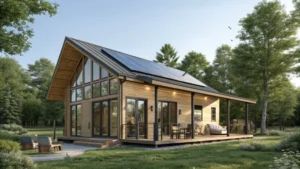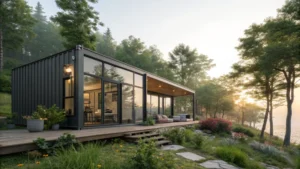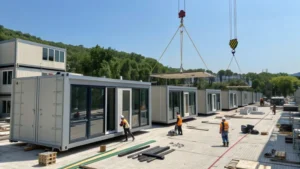%[A tiny home on a green property surrounded by flowers and trees.](https://cozehouse.com/wp-content/uploads/2024/12/tiny-home-in-green-property.webp "Tiny Home on Green Property")
I remember the excitement of dreaming about placing a tiny home on my property. It felt like a step toward freedom and sustainability.
**The rules and regulations for placing tiny homes vary significantly by location, covering zoning laws, building codes, and permits. Important factors include whether your home is on wheels or a foundation, compliance with local building standards, and access to essential utilities.**
When I first explored the idea, I realized how complex the regulations could be, depending on where you live. You see, it's not just about finding a plot of land and plopping down your tiny haven. There's a maze of zoning laws, building codes, and permit requirements that must be navigated.
In some places, tiny homes can sit comfortably in residential zones, but in others, they might need to meet specific standards or be placed on a foundation. I learned this the hard way when I initially thought I could park my tiny home anywhere. Whether your tiny abode is on wheels or set on a foundation can drastically change the legal landscape.
It's also crucial to think about utilities—water, sewage, and electricity. Some regions demand connections to public utilities, while others allow off-grid setups. When I was planning, I had to consider all these factors carefully to make sure my dream home was not only cozy but also compliant with local laws.
If you're considering this journey, take the time to research local regulations thoroughly. It's a rewarding process but one that requires due diligence to ensure your tiny home is both a legal and a personal sanctuary.
Tiny homes are universally allowed on all properties.False
Zoning laws and building codes vary by location, affecting placement.
Building codes for tiny homes differ by region.True
Each region has unique building standards impacting tiny home regulations.
*[THOWs]: Tiny Homes on Wheels
## What Zoning Laws Affect Tiny Homes?
Imagine stepping into a tiny home, feeling both freedom and coziness. But, before you settle in, there's a maze of zoning laws to navigate.
**Zoning laws affecting tiny homes differ by region, dictating placement and conditions. They focus on residential and mixed-use zones, building codes, and utility needs.**
%[A cozy tiny home surrounded by trees in a rural setting.](https://cozehouse.com/wp-content/uploads/2024/12/cozy-tiny-home-rural-setting.webp "Cozy Tiny Home in Nature")
### Residential and Mixed-Use Zones
You know that feeling when you find the perfect spot for your tiny home, only to be hit with a "not-so-fast" by local zoning laws? In residential zones, it's common for rules to dictate minimum sizes or even mandate permanent foundations. I remember when I first explored this option; it felt like every zone had its own personality, each one playing gatekeeper to my tiny home dreams. On the brighter side, [mixed-use zones](https://www.tinyhouseplans.com/blogs/guides/understanding-building-codes-and-zoning-laws-for-tiny-houses?srsltid=AfmBOoqTUVrzzFeTJdr9EUUK6tNuA7mR62CJ5IB70-q3YesOllfqFQ1Q)[^wzlath-1] often offer more wiggle room, blending residential and commercial uses, making them a potential haven for tiny homes.
### Building Codes and Foundations
Navigating building codes can feel like walking through a labyrinth. My first encounter with these rules was like trying to decipher a different language—[plumbing](https://www.tinysociety.co/articles/tiny-house-laws-united-states/)[^wzlath-2], electrical systems, and structural integrity standards all have their say. The decision of whether your tiny home sits on a foundation or wheels can change everything, even its classification between a permanent dwelling and an RV.
### Land Use & Permits
Ah, permits—the necessary paperwork that can make or break your tiny home journey. I recall spending countless hours poring over local regulations to ensure every "i" was dotted and "t" crossed. Whether you're eyeing private or public land, understanding these intricacies is crucial to avoid any legal hiccups.
| **Zone Type** | **Key Considerations** |
|-----------------|--------------------------------|
| Residential | Size, permanence |
| Mixed-Use | Compliance, flexibility |
| Recreational | Suitable for tourism |
### Utility Hookups and Infrastructure
When it comes to utilities, it's like trying to connect the dots between your needs and what's allowed. Some regions are flexible with off-grid solutions, while others demand traditional hookups. I once had a project stall because I underestimated how stringent local utility regulations could be.
### Tiny Homes as Accessory Dwelling Units (ADUs)
In many cities, ADUs have become a gateway for tiny homes to enter urban landscapes legally. However, these come with their own set of hoops—size restrictions and owner-occupancy rules often apply. The concept reminds me of a friend who turned their backyard into a cozy tiny home haven, navigating every regulation with the patience of a saint.
### Transportation and RV Parks
For those who love the idea of mobility, tiny homes on wheels might sound like the ultimate freedom. But just like finding the perfect parking spot in a busy city, landing your tiny home in RV parks or campgrounds comes with its own set of rules—size limits and residency duration included.
Understanding these zoning intricacies isn't just about avoiding roadblocks; it's about carving out your space in the tiny home world. By diving into regional regulations, you can find the best way forward whether you're dreaming of a single cozy dwelling or planning an entire tiny home community.
Tiny homes must be on a permanent foundation in all zones.False
Not all zones require tiny homes to be on a permanent foundation.
Mixed-use zones may allow tiny homes for residential use.True
Mixed-use zones often permit both residential and commercial uses.
[^wzlath-1]: Learn about how mixed-use zoning can accommodate both residential and commercial structures, offering more flexibility for tiny homes.
[^wzlath-2]: Understand the building code requirements that tiny homes must meet to ensure safety and legality.
## How Do Building Codes Apply to Tiny Homes?
Ever wonder if your tiny dream home can comply with local building codes?
**Building codes for tiny homes vary by location, type, and use. Key factors include zoning laws, structural standards, utilities, and whether it's classified as a permanent dwelling or an RV.**
%[A small modern tiny home surrounded by greenery](https://cozehouse.com/wp-content/uploads/2024/12/tiny-home-in-nature.webp "Tiny Home in Nature")
### Zoning Laws and Tiny Homes
When I first considered setting up my tiny home, the maze of zoning laws was daunting. It's a bit like trying to find the perfect spot for a picnic—where you can sit depends on the park's rules. In residential zones, tiny homes might be welcome guests, but they often need to meet certain size and permanence criteria. Picture this: some areas demand a minimum square footage or insist that your tiny home sits firmly on a permanent [foundation](https://www.tinysociety.co/articles/tiny-houses-on-foundations/)[^hdbcatth-1].
- **Residential Zones**: Here, you’ll likely need to align with local residential building codes.
- **Mixed-Use Zones**: These areas can be tricky since you have to juggle both residential and commercial codes.
- **Recreational Zones**: Perfect for tiny homes as temporary getaways, especially in tourist spots.
### Building Codes Compliance
Ensuring my tiny home met building codes felt like solving a giant puzzle. These codes cover everything from the sturdiness of your walls to how well your plumbing and electrical systems are set up.
| Type of Home | Classification | Common Requirements |
|--------------|----------------|---------------------|
| On Foundation| Permanent | Must comply with residential building codes |
| On Wheels | RV | Adheres to RV park or mobile home standards |
- **Foundation vs. Wheels**: If your tiny home is on wheels (THOWs), it’s often treated like an RV, meaning it has a different set of codes than those on solid foundations. In some places, only homes on foundations are acknowledged as legal residences.
### Utility Connections and Infrastructure
Connecting my tiny home to utilities was another adventure. Some places demand you hook up to public utilities, but there’s a growing acceptance of off-grid solutions.
- **Water, Sewage, and Power**: While public utility connections are often required, off-grid options like solar panels and composting toilets are gaining popularity.
- **Off-grid Options**: These provide flexibility but still need to meet local safety standards.
### Tiny Homes as Accessory Dwelling Units (ADUs)
As municipalities warm up to the idea of tiny homes as ADUs, you’ve got more opportunities to expand your living options. But remember, this comes with its own set of rules.
- **Size Restrictions**: Typically smaller than the main house.
- **Owner-Occupancy**: Some regions require that either the main house or the ADU is owner-occupied.
Navigating the evolving landscape of tiny home regulations requires staying informed about local laws and [regulations](https://www.tinysociety.co/articles/tiny-house-laws-united-states/)[^hdbcatth-2]. Keeping up with these changes ensures that your tiny home remains compliant while maximizing your living experience.
For a deeper dive into zoning requirements and their impact on tiny homes, exploring how various states manage these regulations can offer valuable insights. Understanding these details will help you set up your tiny home smoothly and legally.
### Specific Regional Considerations
Recognizing that regulations vary widely is crucial:
- **United States**: Every state marches to its own beat; California allows tiny homes as ADUs with conditions.
- **Europe**: Some countries like Germany embrace eco-friendly housing, whereas others are more stringent.
- **Australia**: Rules hinge on whether you’re in rural or urban locales, with more flexibility in less populated areas.
Understanding these regional differences helps ensure compliance when choosing where to place your tiny home. Delving into local zoning laws and building codes will equip you to tackle the complexities of this alternative living [choice](https://www.mycountrycabin.com/article/pros-and-cons-tiny-house-living)[^hdbcatth-3].
Tiny homes on wheels are classified as RVs.True
Tiny homes on wheels must adhere to RV park or mobile home standards.
All tiny homes must connect to public utilities.False
Off-grid options like solar panels and composting toilets are acceptable.
[^hdbcatth-1]: Discover the benefits and regulations of placing a tiny home on a permanent foundation.
[^hdbcatth-2]: Learn about varying state regulations for tiny homes to ensure legal compliance.
[^hdbcatth-3]: Explore why more people are choosing the tiny home lifestyle and its unique benefits.
## What Permits Do You Need for Placing a Tiny Home?
Navigating the maze of tiny home permits can feel like a never-ending quest, but don't worry—I've been there, and I'm here to help.
**You'll need to navigate local zoning laws, building codes, and acquire specific permits to place a tiny home. Requirements differ by location and may include permanent foundations or utility hookups.**
%[A cozy tiny wooden home on a grassy knoll surrounded by trees.](https://cozehouse.com/wp-content/uploads/2024/12/cozy-tiny-home-on-knoll.webp "Cozy Tiny Home")
Embarking on the journey to place a tiny home is akin to charting a course through a labyrinth of legalese. When I first considered downsizing, the sheer amount of red tape was daunting. However, understanding each step made the process far less intimidating.
### Zoning Laws
Tiny homes must align with local zoning regulations, which often vary between residential, mixed-use, and recreational zones. In residential zones, [tiny homes](https://www.tinysociety.co/articles/tiny-house-laws-united-states/)[^wpdynfpath-1] might need to meet size standards or be placed on foundations.
**Zoning Categories:**
| Zone Type | Description |
|------------------|-----------------------------------------------------------------------------|
| Residential | Typically requires homes to meet specific size and permanency standards. |
| Mixed-Use | Combines residential and commercial uses; may offer more flexibility. |
| Recreational | Ideal for eco-tourism; often allows placement in campgrounds and resorts. |
### Building Codes
Building codes ensure that your tiny home is safe and sound. I learned that whether your tiny abode rests on wheels or a foundation makes a huge difference in what's required. A [tiny home on wheels](https://www.rvia.org/system/files/media/file/Tiny%20Homes.pdf)[^wpdynfpath-2] might be treated like an RV, which comes with its own set of rules.
### Land Use Permits
Placing a tiny home on private or public land requires careful consideration of land use laws.
**Permit Considerations:**
- **Private Land:** Verify zoning compatibility.
- **Public Land:** Check for special permits and environmental approvals.
### Utility Hookups and Infrastructure
Access to utilities such as water, sewage, and power is essential. Many areas mandate tiny homes be connected to public utilities or allow off-grid solutions with [compliance](https://www.tinyhomebuilders.com/learn/tiny-house-utilities)[^wpdynfpath-3].
### Tiny Homes as Accessory Dwelling Units (ADUs)
Many municipalities permit tiny homes as ADUs under certain conditions. They often include restrictions like:
- Size relative to the main dwelling.
- Owner occupancy requirements.
- Minimum lot size for placement.
For those looking to explore [tiny home communities](https://www.bobvila.com/articles/tiny-house-communities/)[^wpdynfpath-4], zoning adjustments might allow clustering small homes together. These communities often have tailored permits for tiny homes.
### Transportation and RV Parks
If your tiny home is mobile, RV parks can offer legal parking options. These parks often have specific regulations like size limits and time restrictions. Constant checks on [zoning laws](https://www.tinyfest.events/tiny-house-zoning-laws-and-building-codes/)[^wpdynfpath-5] are crucial for businesses using tiny homes for temporary setups.
Consider exploring [country-specific regulations](https://www.tinysociety.co/articles/tiny-house-laws-united-states/)[^wpdynfpath-6] as they vary significantly. For instance, California is more accommodating of tiny homes as ADUs compared to other states.
**Table: Regulations by Region**
| Region | Key Regulation Highlights |
|--------------|-------------------------------------------------------------------------------|
| USA | State-specific; California supports ADUs widely. |
| Europe | Germany and the Netherlands favor eco-friendly homes. |
| Australia | Rural areas support tiny homes but urban areas require specific permits. |
Understanding these regulations ensures your tiny home placement is both legal and functional, allowing you to focus on enjoying your unique living space.
Tiny homes must meet local zoning regulations.True
Zoning laws dictate where tiny homes can be legally placed.
All tiny homes require permanent foundations.False
Some tiny homes on wheels are classified as RVs and don't need foundations.
[^wpdynfpath-1]: Discover residential zone requirements for tiny homes to ensure compliance with local laws.
[^wpdynfpath-2]: Learn how tiny homes on wheels are classified and what regulations apply.
[^wpdynfpath-3]: Find out how to connect your tiny home to essential utilities legally.
[^wpdynfpath-4]: Explore the concept of tiny home communities and their regulatory benefits.
[^wpdynfpath-5]: Check current zoning laws to ensure your temporary setup meets local standards.
[^wpdynfpath-6]: Understand the different rules across countries to plan your tiny home placement effectively.
## Can Tiny Homes Be Considered Accessory Dwelling Units (ADUs)?
When I first stumbled upon tiny homes, I was intrigued by their charm and efficiency. But are they really considered Accessory Dwelling Units (ADUs)? This question is crucial for anyone diving into the world of tiny living.
**Yes, tiny homes can be classified as Accessory Dwelling Units (ADUs) if they adhere to local zoning laws, building codes, and land use regulations. These often cover size, foundation requirements, and utility hookups.**
%[A modern tiny home surrounded by a colorful garden](https://cozehouse.com/wp-content/uploads/2024/12/tiny-home-in-vibrant-garden.webp "Tiny Home in Garden")
### Understanding ADUs and Tiny Homes
The concept of Accessory Dwelling Units (ADUs) fascinated me when I learned they could be a hidden gem for maximizing space on a single-family lot without the burden of new land development. As I delved deeper, the minimalist allure of tiny homes caught my attention, offering a lifestyle that embraces simplicity without sacrificing comfort. Imagine waking up in a cozy nook with everything you need right within reach—it's like a dream come true!
### Zoning Laws and ADU Designation
Navigating zoning laws can feel like piecing together a complex puzzle. I discovered that in many areas, tiny homes can indeed qualify as ADUs if they meet specific zoning criteria. These rules often dictate where and how tiny homes can settle, particularly in residential zones where size might be an issue. It reminded me of a friend who excitedly shared how they managed to position their tiny home in a mixed-use zone, balancing both residential charm and commercial practicality.
| Zoning Type | Tiny Home Status |
|-----------------|-------------------------------------------------------|
| Residential | Allowed with size/permanence standards |
| Mixed-Use | Must comply with both residential/commercial codes |
| Recreational | Commonly allowed in tourism-oriented areas |
Understanding these distinctions is key for those looking to utilize tiny homes as ADUs.
### Building Codes Compliance
For tiny homes to step into the ADU category, adhering to building codes is non-negotiable. I remember vividly helping a neighbor install their tiny home's foundation—oh, the thrill of transforming what was once just wheels into a permanent abode! Whether your home rests on a solid foundation or remains mobile can change its classification drastically, sometimes falling under [RV regulations](https://www.rvia.org/system/files/media/file/Tiny%20Homes.pdf)[^cthbcadu(-1].
### Utility Hookups and Infrastructure
The practicalities of utility hookups were a learning curve for me. Ensuring water, sewage, and power connections meet local standards is paramount. My exploration into off-grid solutions like solar panels was an eye-opener—ideal for those craving independence while still adhering to safety codes.
### Legal Variability Across Regions
One size doesn't fit all when it comes to regulations. The legal landscape changes dramatically depending on where you are. For instance, California's warm embrace of tiny homes as ADUs has been inspiring. Meanwhile, European countries like Germany are paving the way for eco-friendly housing solutions. This variability makes each journey into tiny home ownership unique, offering both challenges and rewards.
Each aspect of using tiny homes as ADUs unravels new layers of understanding, guiding us toward innovative living solutions that blend modern convenience with timeless simplicity.
Tiny homes can always be considered ADUs.False
Tiny homes must meet specific zoning laws and building codes to qualify as ADUs.
California allows tiny homes as ADUs with specific guidelines.True
California has regulations that permit tiny homes as ADUs, subject to size and utility rules.
[^cthbcadu(-1]: Learn about how RV regulations impact tiny homes on wheels and their classification as dwellings.
## Conclusion
Tiny home regulations vary by location, covering zoning laws, building codes, and utility requirements. Understanding these rules is essential for legal placement and compliance.



